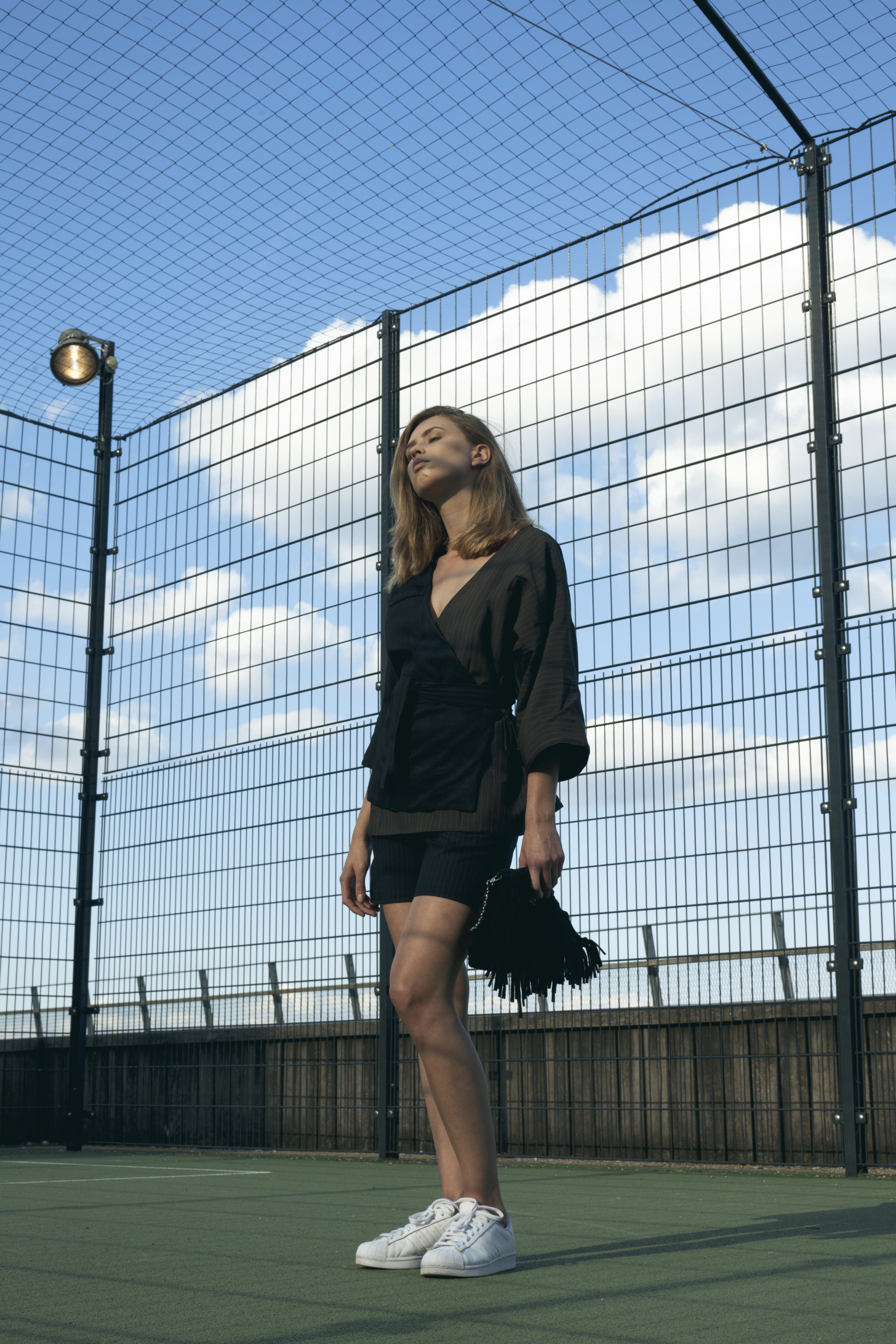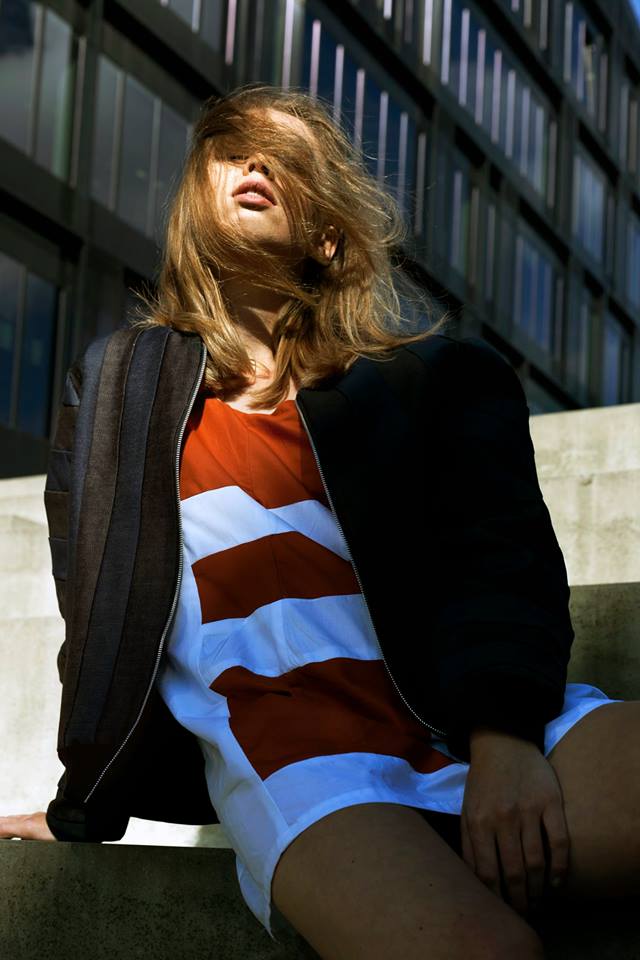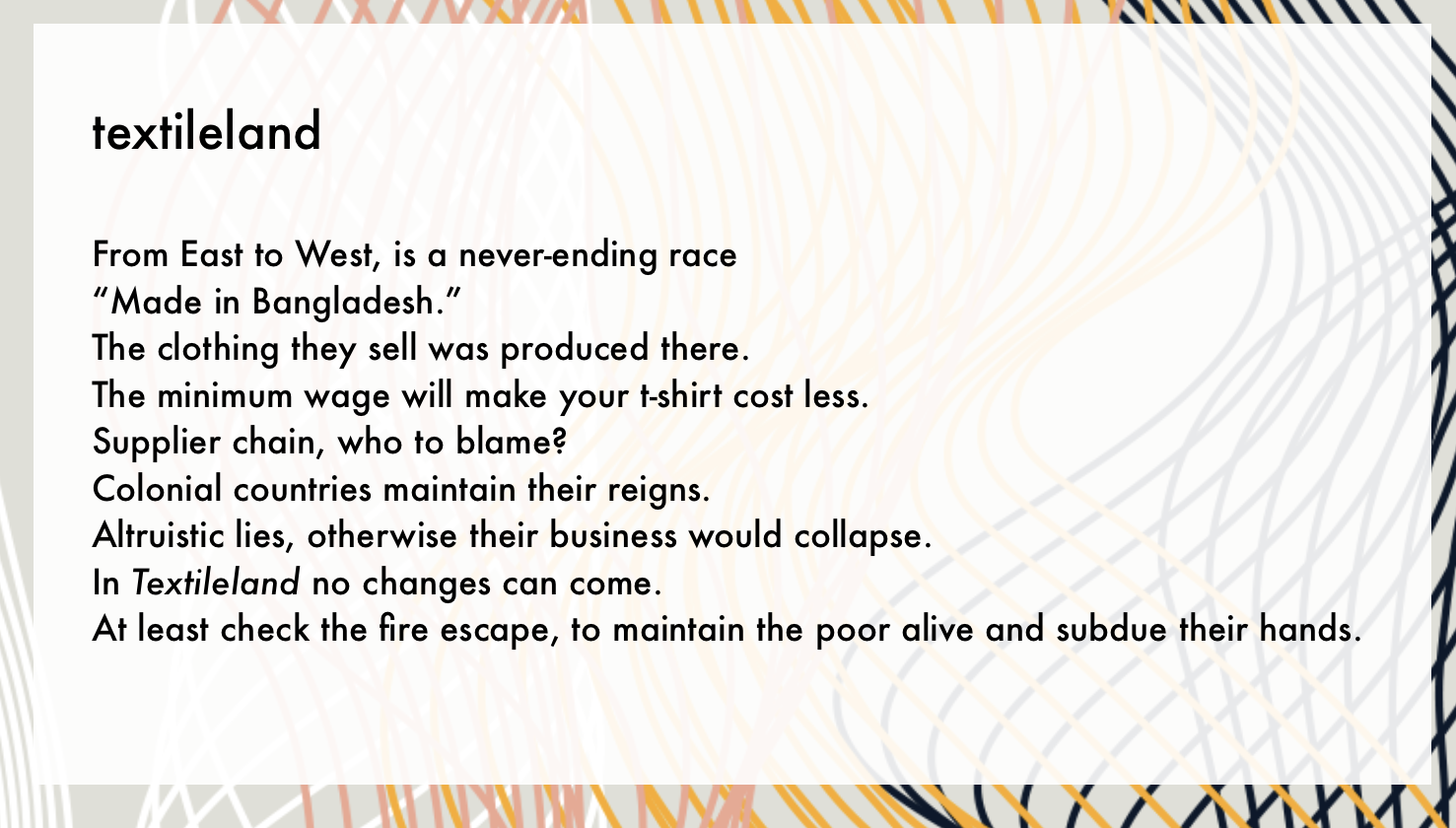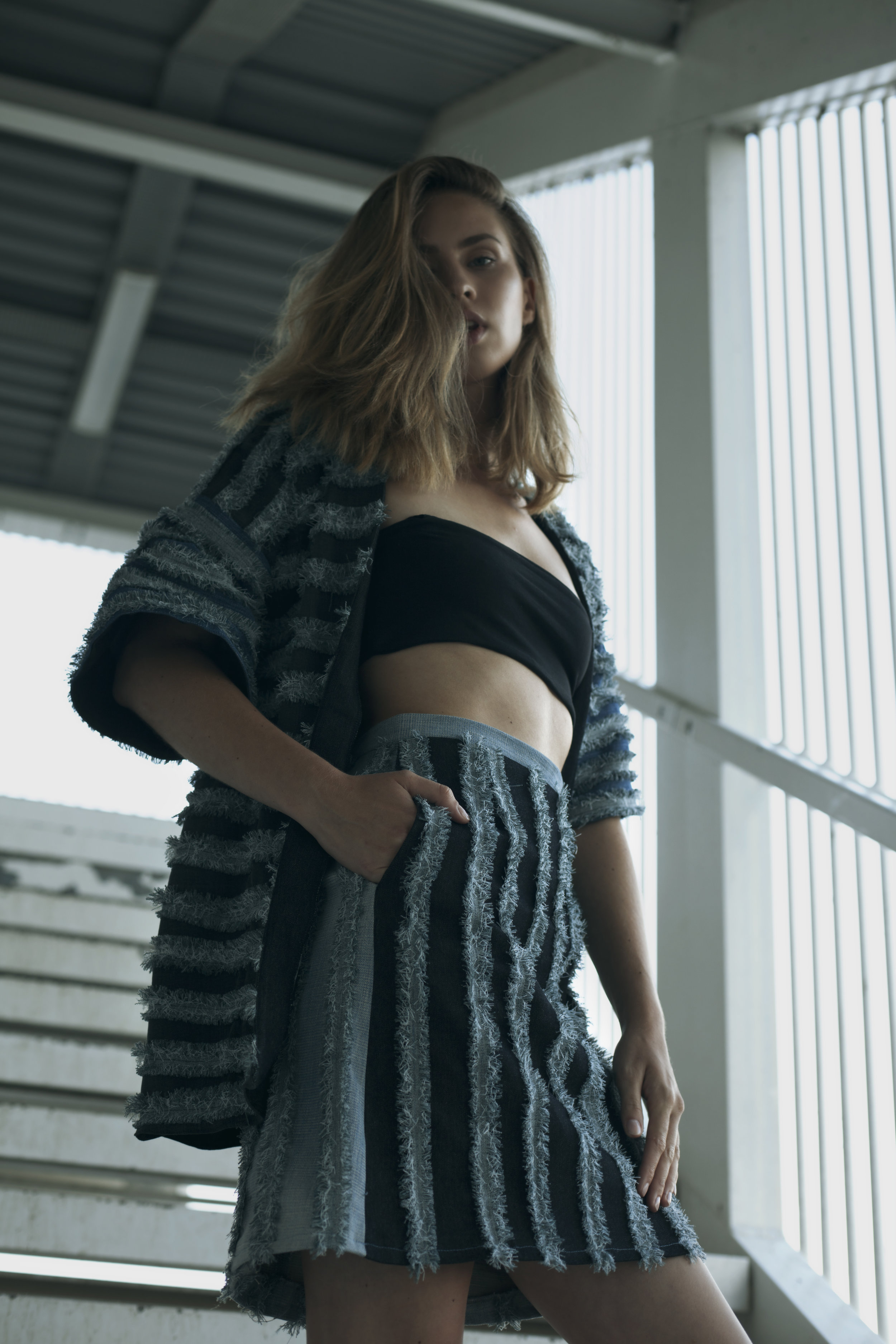Re.Imagine
Re.Imagine is a brand designed by Brittany Malvino and Michelle Bjerregaard Jensen and partnered with the Red Cross of Denmark. Created with the goal of minimizing textile waste, it aims to upend the norms of the fashion industry, seeking new and innovative solutions to design and material challenges. Here, the creators tell the story of their venture into the world of sustainable fashion, asking: can modern design that relies on the past hold aesthetic interest for consumers obsessed with the new?
On a snowy day just an hour outside of Copenhagen, Denmark, we stare at high stacks of large metal cases filled with clothes, shoes, and accessories, reaching the roof of the massive Red Cross warehouse. At great speed, five volunteers sort through garments as they whiz by on a conveyor belt in the middle of the warehouse. Every now and then, a garment is put aside to be sent to a second hand shop, while the rest are destined to be sent around the world to other locations.
Puzzled by what we see, we sit down with Martin Jensen, the head of the center, to discuss clothing waste solutions and the fashion industry. He explains to us that his center alone receives 290 tons of clothing every month and the numbers continue to increase. Some garments are crisp new, but most show evidence of wear through either stains, folds, or holes. While many view these damaged designs as trash, we choose to think outside of the box, looking at them with future opportunity and material value in mind. These garments once had a purpose and, whether long or short, they tell a story of a previous life. We understood that by being donated instead of thrown away, these garments had the potential to carry on, but if they are damaged, how long-term might that potential be?
Aesthetic Experiences
When getting off at the central station in Copenhagen and walking through the busy streets, one is immediately bombarded with different impressions of colors, patterns, textures, people, buildings, and stores. Looking around the cityscape, you start to realize that it’s filled with fast fashion advertisements. You see images of the cardigan in the colour of the season, the jeans that are cut with a frayed hem, the dress with the beautiful floral print: trends that you simply can’t live without. Fast fashion is a radical method of retailing that has broken away from the pattern of seasonal selling by putting out new inventory throughout the year at a low price. [1] In the moment, fast fashion may seem like the key to happiness, but it is short lived and ultimately leaves you with low quality designs that become aesthetically obsolete. [2]
As a result, we are faced with the fact that design work is connected closely to a commercial agenda where resources are being transformed into products at an alarming rate, all to ensure thriving bottom lines. Fast fashion runs on the basis of planned obsolescence. [3] With never ending amounts of clothing at our disposal, the consumer has replaced the appreciation for quality and craftsmanship with trends and overflowing closets. This moves us in a direction where consumers prioritize quantity over quality, which is now the norm of consumption — a fact which has led to the degradation of our environment.
In the search for constant newness and trying to keep up with the latest trends, people have forgotten the value of craftsmanship, genuine design, and originality. We feel it necessary to bring old values back into play, through time and a strong design process. When thinking of these concerns, it leads us to an overall question, how can we find a more durable approach to fashion and offer sustainable alternatives for those who constantly need a new closet? Implementing exceptional craftsmanship and quality storytelling can very well be a way of increasing the durability lost in fast fashion. One of the main flaws within the fast fashion system is that consumers don’t necessarily find a connection with the products they buy, but instead are driven by chasing the new trend of the season.
When visiting the Red Cross warehouse we noticed that most of the clothing coming down the conveyor belt had a fast fashion label. Clothing that was in perfect condition was now lying in piles getting ready to be sent to a factory and transformed into car insulation material. The resources both in regards to energy, chemicals, water, and raw materials put into these garments were being wasted all for the thrill of a quick buy. To create a thriving sustainable fashion industry, one can look into prolonging the active life of these garments through aesthetic experiences.
Experiences such as running your hands over the knitted blanket your grandmother made you when you were young evokes emotion and memory. You can feel the many hours it took to make the intricate patterns and you discover small irregularities, which adds character to the blanket, in contrast to the “perfect” machine knit you came across on sale at the store the other day. These imperfections from the blanket represent the human hands behind the product. By making use of traditional techniques, skills, and crafts while implementing a bit of innovation, we encourage the consumer’s awareness of the skilled set of hands that created this authentic experience. By doing so, it pushes us towards recognizing the feeling of craftsmanship and valuing the time and skills placed in a product.
It’s about quality over quantity and understanding how to choose the right product from the beginning. By changing the mindset that overconsumption is no longer a status symbol, we are able to move towards a more circular system and bring back quality aesthetic appreciation. Once the designer and consumer have developed this understanding, we can move away from valuing the cheap “bargains” found in fast fashion stores and fill our closets with garments with which we have an emotional connection.
Re.Imagine
With these thoughts in mind, Re.Imagine was formed. Upcycling, the process of gathering discarded materials to be transformed into new products of higher quality, was not a mystery to us. Sitting together at Kea, Copenhagen School of Design and Technology, we looked into our classroom filled with leftover old garments donated to us for a social inclusion project. We were shocked, that as 30 students gathered as much clothing as they could to experiment, transform and inspire, there was still a room covering the floor with unwanted garment designs and accessories. Looking at this mess of textiles, we realized there was a prominent flaw within the industry and we were staring directly at it. As the speed of the industry increases and the quality decreases from fast fashion, consumers lose their emotional connections with their clothing. As a result, we end up with this: a room full of textiles holding labour, water, and raw materials being wasted. With an interest in changing this pattern and shaking up the industry, we made contact with the Red Cross of Denmark and pitched an idea to rethink the system and find new creative life for damaged textiles.
Through the use of donated garments from the Red Cross, Re.Imagine was born, creating modern designs from materials of the past. We focus on designing high-street styles that are one of a kind and created through the process of upcycling. Our desire was to design styles that transformed fast fashion materials and inspiration into sustainable creations. Our goal was to flip the image of boring sustainability and embrace forward-thinking styles. The interest of our design process was to make use of existing garments and transform them into new and desirable designs to be cherished for their own aesthetic appeal as well as their sustainable creation.
For the next few months we sketched, experimented and turned our sewing room into an exhilarating, ambitious & fun studio preparing for our first collection launch on September 9th, 2016. We embraced the work of the designer, which is fundamental in creating sustainable products. Through the design process you get to test your ideas, research different inspiration, draw, manipulate textiles, and innovate until you are left with solutions that work and that are aesthetically appealing and original. Ultimately you get to form an aesthetic experience for the consumer, which is an emotional experience containing sensuous delight and which often implies both visual and tactile stimulation between the product and consumer. [4] The aesthetic experience can lead to an emotional connection, which creates a possibility for a long lasting bond and therefore becomes aesthetically nourishing over time. To do so, we created designs involving patchwork, crochet bags, and fringe techniques.
On the day of our fundraising event, we accomplished just this. To prepare, we ran excitedly through the cobbled streets of Copenhagen, trailing behind us our 100 piece collection of denim bomber jackets, leather backpacks and fringe Kimonos embodying an aesthetic and sustainable experience. At 4pm, the doors swung open and consumers from all walks of life piled in to view the results and purchase one-of-a-kind sustainable designs from our first collection, Redefining Lines. The event began a conversation about the future of sustainability and new possibilities for design methods.
With success at our fingertips we knew there was more we could do. Immediately following the closing of our first collection, we started to brainstorm how to make an even larger impact within the industry. Collaboration was the key throughout our brand and we wanted to take this one step further. So, along with the Red Cross, we decided to team up with other sustainable fashion designers from around the world living in Copenhagen, to join the Re.Imagine team and expand the possibilities of creativity. As a result, the partnership Re.Imagine X Future Designers was created.
This partnership was created to highlight the new sustainable designer emerging in the industry, to showcase their own aesthetic interests through a collaborative collection. It involved 13 creative minds living in Copenhagen and was launched during Copenhagen Fashion Week 2017. As a result our second fundraising event was held on January 31st, 2017, featuring a denim inspired collection holding pops of color and tactile experiences.
Re.Imagine was a stepping stone in the right direction for textile waste minimization and sustainable reinterpretation. Not only did we want to pave the way for conscious design improvements within the industry, but also to blur the lines of different industries working together. Through Re.Imagine, philanthropy and high fashion came together with a common goal of improved supply systems and industry impact. It proved to consumers that covetable styles could be sustainable and that truly modern design was achievable. Our interest was in opening the possibility for new industry collaborations and creating a fashion reformation that was aesthetically pleasing and environmentally beneficial.
Final Thoughts
With the fashion industry we have today and the amount of textile material available to us, upcycling is a great process for anyone to have the opportunity to challenge their creativity and create something out of the ordinary. Today mass production has directed us away from a sensual aesthetic experience and has left us craving the latest trends, homogenizing our individual desires.
A statement by Oscar Wilde is so relevant today: “Fashion is a form of ugliness so intolerable that we have to alter it every six months.”[5]. The fashion industry revolves around constant changing trends that consumers feel the urge to follow. The fast shifting trends fuel overconsumption and people change their wardrobes quarterly to keep up with the pace. Garments are only worn once or twice before moving onto the next trend, becoming ugly and undesirable. With the fashion industry being the world’s second most polluting industry, it’s essential to challenge the way the system works to create a more circular industry.
Through Re.Imagine we took on textile waste within the industry and strived to create a new and beautiful story. Our garments thrived on the idea of new modern life and we wanted to give consumers all around Copenhagen a unique design to cherish. Our collaboration with the Red Cross blended industry worlds together to show that any type of collaboration is possible. Through sustainable intentions and modern design inspiration, not only did we develop a new supply system possibility to minimize textiles, but we also questioned the norms of the industry. To answer the overall question from the beginning, it is possible to create new garments from the past for those who enjoy the new. What we have learned from sustainability and our business ventures is that the aesthetic experience is important and strong design connection matters. Fashion is a multibillion dollar industry with a mark all over the world, but sustainability is here to shake up the system and create new life for garment design.
Notes
[1] Cline, Elizabeth L, 2013. Over-Dressed: The Shockingly High Cost of Cheap Fashion
[2] Walker, Stuart, 2006. Sustainable by Design: Explorations in Theory
and Practice. Edition. Routledge.
[3] Chua, Jasmine. 2014. Vanessa Friedman: “Driving Force of Fashion is Planned Obsolescence.Available at: http://www.ecouterre.com/vanessa-friedman-driving-force-of-fashion-is-planned-obsoles- cence/. [Accessed 4 December 2016].
[4] Harper, Kristine. 2012. Aesthetic sustainability.Available at: http://textiletoolbox.com/research-writing/aesthetic-sustai/.
[5] Seywright, Simon, 2012. Basics Fashion Design 01: Research and Design: Second Edition






